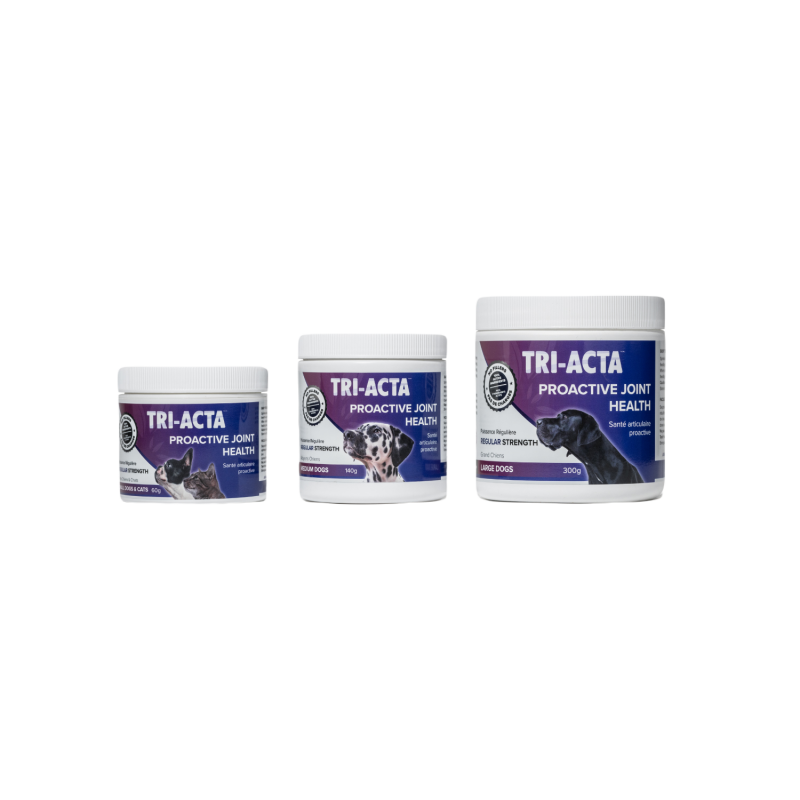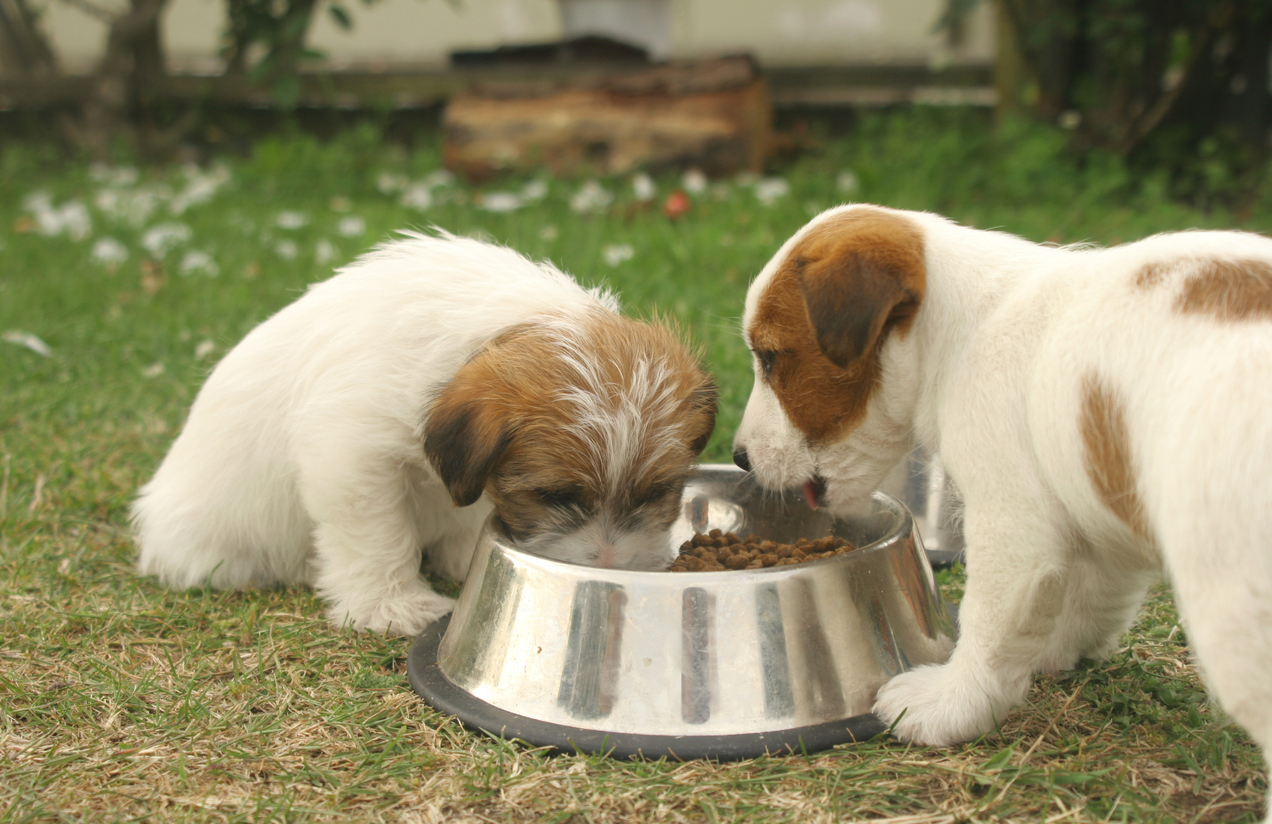Table of Contents
Getting a new puppy is exciting! You’ve likely prepared for your new arrival by purchasing a bed, collar, leash, and more than a few toys as part of your puppy prep to help your pup settle into their furever home.
But the decision may not be so easy when it comes to food. There is tons of information online about providing the best nutrition for your brand-new puppy. From a raw food diet for dogs to canned wet food and dry kibble, you can make several choices.
Of course, people have different thoughts and opinions about which type of food is better, but we’re here to provide the facts.
There are a number of reasons why you would choose to feed your young dog dry puppy food:
- It’s convenient to feed to your dog
- It’s easy to store
- It can be safely left out for your dog for more than an hour or two
- It’s often less expensive compared to wet and raw food diets
- It can be mixed with other types of food (raw and wet) to provide additional nutrients
Plus, dry puppy food is yummy! Your pup will enjoy the crunch of the kibble, and if it turns out that they are a pickier eater, there are a ton of options that you can try:
- Adding water to the food to create a “gravy”, making the kibble more palatable
- Adding a food topper like beef liver powder or flavoured probiotic powder
- Mixing the dry food with some bone, vegetable, or meat broth (can be purchased at pet stores or made at home)
As you can see, dry puppy food is very versatile—all the more reason to feed it to your pup!
But as soon as you look online and try to get information about how to choose the best dry puppy food, there are so many considerations to keep in mind, including labelling, nutritional value, and ingredients, that all of that information can seem overwhelming.
In this article, we discuss the ins and outs of how you can choose the best dry puppy food—without all the jargon.
How Do I Know My Puppy is Ready for Dry Puppy Food?
Before purchasing a bag of kibble, it’s important to ensure your puppy is ready to eat dry puppy food. As part of regular puppy nutrition, generally, a puppy is ready to eat dry kibble when they are 8–10 weeks old.
If you’ve adopted a puppy from a reputable breeder or shelter, generally, they will be fully weaned. However, if they are not, for whatever reason, the person who facilitated the adoption should let you know. If you have a unique situation where you’ve adopted a puppy that hasn’t yet gone through the weaning process, consult a veterinarian for detailed new puppy tips, including how to wean the dog properly.
While 8–10 weeks is the average age that puppies can start eating solid food exclusively, it can vary depending on the puppy. This is because puppies need to complete their weaning stage, which is when they transition from mother’s milk or formula to solid puppy food, and the weaning process may be shorter or longer by a few weeks, depending on the dog.
During the weaning stage, puppies will start to become interested in the solid food their mom is eating and might even try to eat some. At this point, it’s best to let them investigate soft food, so either small portions of canned wet food or kibble mixed with some water to make it soft. The puppy will likely eat some of the food in addition to suckling their mother. If you’re feeding them formula, it’s important to continue to do so and introduce the solid food gradually in small amounts.
Feeding Your Puppy For the First Year
For the first year of your puppy’s life, your puppy is going through a lot of milestones as their little body matures. Feeding your puppy appropriately is important to make sure that they have the nutrients they need to develop and thrive.
The table below provides a guideline on how to feed your puppy in the first year of their life:
|
Age |
Feeding Guidelines |
|
6–12 weeks |
|
|
3–6 months |
|
|
6–12 months |
|
|
1+ years |
|
A Note About Portion Sizes and Feeding Times
It can be tough to know how much to feed your dog, especially when transitioning them to a regular solid food feeding schedule. Puppies are used to suckling at mom whenever they want, but they’ll soon find out that the food bowl isn’t the same as a bottomless milk bar!
Just like human babies, puppies need many small meals per day. Usually, the best puppy food brands will indicate how much each portion should be, but if you find your pup not eating the entire meal within 10–20 minutes, it might be too much for them. Of course, always consult your vet if you have concerns about feeding your puppy properly.
Why Opt For Vet-Recommended Puppy Food
Now that you have a basic guideline for how to feed your puppy, the most important step is choosing the best dry puppy food. One type of dry puppy food to consider is vet-recommended. Usually, food that is labelled “vet recommended” or “vet formulated” is made to assist in treating a specific condition that your puppy has, including:
- Allergies
- Digestive issues
- Urinary issues
- Thyroid, or other diseases
In some cases, vet-recommended puppy food might state that it’s formulated to cater to a specific breed. Unfortunately, these breed-specific foods are really more of a marketing gimmick than anything else. There’s nothing wrong with the food itself, it’s just that the nutritional requirements of a Golden Retriever are not going to be all that different (if at all) from a Labrador Retriever.
Unless your dog has a condition and your vet recommends a specific food to aid in treating it, regular dog food is fine. However, it is important to consider that specific breeds, like the aforementioned Golden and Labs, are more susceptible to certain conditions, so you may want to add supplements to their diet.
Most dogs will experience some sort of joint issue in their lifetime, and these issues can appear early in a dog’s life, especially when they are a larger breed. Therefore, giving your dog joint supplements early adds a layer of proactive protection for their joint health.
TRI-ACTA is a great preventative joint supplement that can be fed to puppies as soon as they start eating solid foods. As a powdered supplement with 100% natural ingredients, including glucosamine for dogs, chondroitin, and methylsulfonylmethane (MSM), the daily dose is low (based on weight, but starts at 0.5 g for dogs under 10 lbs or 4.5 kg and maxes out at 2–3 g for dogs 75–100lbs, or 35–50 kg) so it’s likely your dog won’t even notice it on their food. Plus, TRI-ACTA is certified by Health Canada as a designated Veterinary Health Product, so you can be sure you’re giving your dog the best.
TRI-ACTA for Pets
A proactive approach for developing and younger adult pets to maintain optimal joint health mobility, minimize inflammation and fend off age-related ailments.

How to Pick the Best Puppy Dog Food
Regulators like the Association of American Feed Control Officials (AAFCO), The Pet Food Association of Canada (The Pet Food Association of Canada also recognizes the recommendations from AAFCO), and FEDIAF, an association representing the European pet food industry, have put together a list of recommendations that you can follow to choose the best dry puppy food for your dog.
1. Look for Food that’s “Nutritionally Complete”
Puppies need different nutrition compared to adult dogs. The dry puppy food you choose should clearly indicate the life stage it’s meant for (obviously in this case, puppies). You should also look for a statement on “nutritional completeness” or “adequacy”, as this information tells you whether the food is meant for regular feedings or only for an occasional treat. If the food says it’s nutritionally complete, that means it must have the correct amount, balance, and availability of nutrients for your pet.
2. Knowing the Difference Between Meat, Meat Byproducts, and Meals
Pet food ingredients can be overwhelming, especially since each company formats their labels differently.
However, one important thing to remember is that pet food ingredients are always listed from most to least on the label.
So, for example, if beef is the first ingredient on the list, it’s a major ingredient in the food. Beef may be followed by water, broth, or meat byproducts or meals. When a pet food says it contains meat byproducts or meals, it can be confusing because these are still meat, right?
Well, yes and no. Here is a breakdown of what the different “meat” ingredients mean when they are listed on pet food labels:
- Meat or poultry: Refers to the flesh of the animal and may contain fatty tissues or other components of the flesh like sinew and gristle.
- Meat byproducts or poultry byproducts: Organs, fatty tissues, and bones (not hair or fur, teeth, or hooves, but with poultry, it can mean feet or heads).
- Meals: Blood, hair, fur, hooves, horns, and skin or hide.
- Byproduct meals: This is the furthest down the line of “meat” products and can include stomach contents, feathers, and even manure.
3. Puppy Food Has Higher Calorie Content
Compared to adult dog food, puppy food usually contains more calories per serving. A typical good adult dog food usually contains around 400 calories per cup, while puppy food is more like 450–500 calories per cup.
The extra calories in puppy food are usually in the form of protein and fat. Adult dogs should get about 18% of their calories from protein, while puppies should get about 22.5%. As a result, usually adult dog foods have 20-25% protein, while puppy food has between 30-40%.
4. Food Size Appropriateness (For Kibble)
Most good puppy food brands will ensure that the size of their kibble matches the fact that the dog that’s going to be eating it is smaller than an adult dog. However, puppies can range significantly in size, just like adult dogs. You might notice a slight difference in kibble size for puppy chow that’s breed-specific versus regular puppy food. Remember that your puppy may have trouble eating if the kibble is too big. If this happens, either break up the kibble further or switch them to a food that provides smaller pieces.
Why You Should Consider High Quality Puppy Food
We all love getting the occasional fast-food burger and fries, but eating that for every single meal every single day wouldn’t be the best choice for your health. The same goes for your puppy. Think about high quality puppy food like you would a healthy, home-cooked meal—much better for your dog compared to cheap food that’s packed with fillers.
Fed is always best, of course, but if you check the ingredients on most of the dog food you can find at the grocery store, you’ll probably find that most of it comprises fillers, additives, and preservatives rather than actual food ingredients.
If you feed your pup low-quality puppy food, you’ll definitely notice that they go number 2 more and that the stools are—ahem—very stinky. This is because fillers, additives, and preservatives are difficult or impossible for your puppy to digest and pass through your dog’s digestive system and onto your lawn in the form of a big, smelly…well, you know the rest.
Poop will always have an unpleasant odor, but you will notice a significant difference in the smell when you feed your dog a high quality puppy food. Their stools will not only be less stinky, but you could also notice your puppy going to the bathroom less often and having less trouble going to the bathroom—because more of the food that you’re feeding them is getting used by their body rather than being passed through as waste products, and it’s easier for your dog to digest.
What is the Healthiest Puppy Food?
If you perform one online search for the healthiest puppy food, you’ll very likely come across many different opinions on which formulation is the best: raw, dry, or wet (canned).
While some may point out that one of these options is better than the other, the truth is that the healthiest puppy food can be raw, dry, or wet; it just depends on the ingredients and whether it provides the nutrition your dog needs. As long as you’re making sure that your dog gets the appropriate nutrients in their raw diet or checking the label of dry and canned dog food for the ingredient list and that statement on nutritional completeness, you’re golden.
Here is a table that compares the different types of healthy puppy food options:
|
Raw |
Dry |
Wet (Canned) |
|
|
Pros |
|
|
|
|
Cons |
|
|
|
As you can see, there isn’t really a formulation of dog food that is better than the other, it all depends on what works best for you and your dog. Whichever food type you decide to choose, be sure that you’re carefully considering the ingredients and nutrition that it provides to your puppy.
Best Puppy Dry Food to Consider This Year
Now that we’ve gone through a variety of tips for choosing the best dry puppy food and compared the differences between the different formulations of healthy puppy food, it’s time to get into our recommendations for the best dry puppy food you can purchase for your best friend.
With each recommendation below, we kept in mind ingredients and nutritional completeness, as well as other considerations that are unique to small-breed and large-breed dogs.
When choosing the best dry puppy food for small-breed dogs, we kept a couple of considerations in mind:
- Small-breed puppy food is typically higher in calories and nutrients than food for larger dogs, as smaller dogs have a higher metabolic rate and burn calories faster.
- Small breed dogs require appropriately sized kibble. If the kibble is too large, it will be difficult for them to eat.
1. Acana Small Breed Recipe Dog Food
When you’re choosing any dog food, it’s important that the brand is transparent about the ingredients they use. Thankfully, Acana provides all the information you could ever need about their food, including how it’s made, its composition, and more—just take a look at the back of the bag!
While your small-breed puppy might need more calories than a large-breed puppy, those calories should comprise good protein and fats—something that Acana puts front and center on their packaging to make it easy to know what you’re giving your dog.
Starts at $23.99 CDN for a 4.4 lb bag. Pricing as of September 2023.
2. Orijen Puppy Food
Another Canadian brand that follows a similar philosophy with labeling their pet food as Acana is Orijen. The main ingredients that this dry puppy food uses are listed right on the front of the bag, and the back of the bag has detailed information on composition and formulation for you to check out.
The big statement on the back about the food being nutritionally complete is a great addition—especially for new puppy owners who might not be as familiar with reading pet food labels.
Starts at $31.99 CDN for a 4.4 lb bag. Pricing as of September 2023.
Best Dry Dog Food for Large-Breed Puppies
When choosing the best dry puppy food for large-breed dogs, we considered the following:
- Large breed dogs need fewer calories and nutrients than small breed dogs. This is because their metabolism works slower.
- The size of the kibble doesn’t matter too much, but a larger kibble is likely preferable. Of course, larger dogs will not have an issue with eating kibble, whether small or large.
1. NOW Fresh Grain Free Recipe for Large Breed Puppies - Turkey, Salmon & Duck
Large-breed dogs may need fewer calories compared to smaller breeds, but those calories have to count. NOW Fresh provides plenty of meat protein and probiotics to support digestion, and this formulation even has green-lipped mussel for dogs to provide some support for your dog’s joint health.
Even with the green-lipped mussel, we recommend incorporating another joint supplement for your large-breed dog, such as TRI-ACTA. While green-lipped mussel has some scientific verifiability that it helps with dog joint health, the therapeutic benefits are usually not as high as a dedicated joint supplement like TRI-ACTA that has glucosamine, chondroitin, and MSM to provide a complete joint health solution.
Starts at $72.99 for a 12 lb bag. Pricing as of September 2023.
2. FirstMate Grain Friendly Formula Large Breed Puppy Food
If your puppy is showing signs of having some sensitivities with food, First Mate is a good option to try. Corn, wheat, and soy are fine in most dog food, but they can be difficult for some dogs to digest. Because of that, First Mate uses easily digestible grains such as oatmeal and brown rice in place of other grains. Plus, they use the entire fish in their formula, so your dog gets the benefits of those extra omega-3 fatty acids.
$53.99 for a 25 lb bag. Pricing as of September 2023.
Summary
When you’re choosing the best dry puppy food, it’s important to keep the ingredients in mind and always look for a statement on nutritional completeness. Puppies need more calories than adult dogs, so puppy food should contain more calories (between 450 to 500 versus less than 400). Food with tons of fillers, additives, and preservatives can cause your puppy to have stinky stools and isn’t the best for their overall health. Giving your puppy high quality puppy food is paramount.
The best puppy dog food brands will always list their ingredients in a clear way, so it’s easy to understand, at a glance, what you are giving your puppy.
Considering that joint issues are common with all-sized dogs, it’s important to get your puppy on a joint supplement as soon as possible. TRI-ACTA provides 100% natural ingredients with low dosage amounts, so it’s easy to administer to your puppy by sprinkling it on their food.
Buy TRI-ACTA online today or learn where to buy in stores.
TRI-ACTA for Pets
A proactive approach for developing and younger adult pets to maintain optimal joint health mobility, minimize inflammation and fend off age-related ailments.

Newsletter Signup
Subscribe to our newsletter to receive the latest news and exclusive offers.
.jpg?height=2000&name=Cliick_Integricare-DISPLAY-REVISEDV2%20(1).jpg)
Proactive & Therapeutic Joint Supplements
When given daily, Integricare joint supplements recover bone and joint injuries faster and help prevent mobility injuries from happening in the first place.











